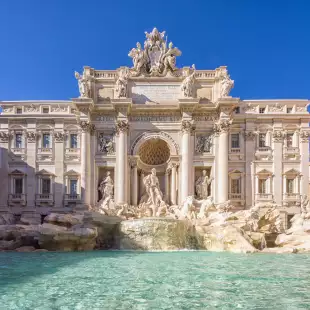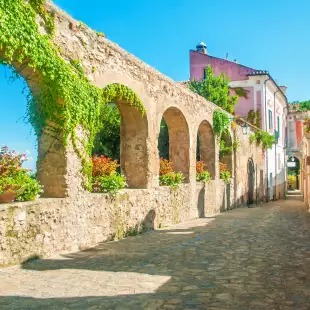10 Best Roman Ruins to Visit in Europe

Discover our incredible European escorted tours and river cruises that let you discover the best Roman ruins in person.
Go on any holiday to Italy, or indeed a European tour and chances are you’ll see evidence that the Romans visited centuries before you. From Rome’s Colosseum to Germany’s Trier Imperial Baths, impressive Roman ruins are often a highlight of a European trip. Here we list ten of the best Roman sights to see on our escorted tours and river cruises.
Immerse yourself in fascinating Roman history on our European escorted tours and European river cruises, visiting ruins including the Colosseum, Pompeii, Trier Imperial Baths and the Aqueduct of Segovia.
Top 10 Roman Ruins To Visit In Europe
1. Colosseum, Rome, Italy
One of the world’s most famous Roman buildings, the Colosseum – or Flavian Amphitheatre as it is also known – was built around 80 CE as a vast entertainment arena. Standing 52 metres high – equivalent to the height of four double-decker buses – it became the site of gladiator contests, animal fights, executions, and battle re-enactments. Some 50,000 spectators would gather to watch gory events, and the Colosseum’s inaugural games lasted 100 days. Today, regardless of where you stroll in Italy’s capital, you’ll stumble upon many ruins of Rome. The Pantheon, Roman Forum, Baths of Caracalla – all can be seen on our Classical Italy tour.

2. Trier Imperial Baths, Trier, Germany
Roman empire ruins found in Trier, Germany’s oldest city, can be visited on our Rhine and Moselle River Cruise, which includes a tour to the Roman amphitheatre and a remarkable fortified gate, Porta Nigra. The Imperial Baths, dating back to around 300 CE, are a must-see too, not least because they are believed to be the biggest Roman baths built outside of Rome. Featuring a substantial hot water bath – used today for theatre productions and large enough to accommodate a stage, orchestra, and 650 seats – the Imperial Baths also had six boiler rooms and an underfloor heating system.
3. Pont Du Gard, Vers-Pont-Du-Gard, France
One of the wonders of the ancient world, the Pont du Gard Roman aqueduct is undeniably a highlight of our Burgundy, the River Rhône and Provence River Cruise. The 2,000-year-old structure, built over the River Gardon in a beautiful natural setting less than 20 miles from Nîmes, is an engineering masterpiece – no wonder the Romans themselves considered the three-storey bridge a testimony to their greatness. Nearly 49 metres tall, Pont du Gard is the highest of all Roman aqueducts. It’s also one of the best-preserved.

4. Pula Arena, Pula, Croatia
Roman ruins are on the itinerary of holidays to Croatia, and our Northern Croatia tour takes in Pula, once a vibrant Roman outpost called Polensium and home to an incredibly well-preserved Roman amphitheatre – it has a near-complete circle wall. Like Rome’s Colosseum, Pula’s Arena was built in the 1st century CE during the reign of Emperor Vespasian and slotted together entirely from local limestone. It’s one of the largest surviving Roman amphitheatres in the world and is the only one remaining with four side towers.
5. Pompeii, Bay Of Naples, Italy
Perhaps the most famous Roman ruins of all, Pompeii is today a vast archaeological site, but back in 79 CE, it was a thriving Roman town. Then on one fateful summer’s day, nearby Mount Vesuvius erupted and obliterated Pompeii, burying it under millions of tons of volcanic ash. Visit Pompeii for an intriguing insight into the Roman way of life – you’ll see streets, shops, homes, and a mostly intact amphitheatre. The question is should you visit Pompeii or Herculaneum, another town that was buried under mud and ash, and is in a better state of preservation? There’s no need to choose between the two – tours to both are included in our Pompeii, Capri and the Bay of Naples holiday.

6. Library Of Celsus, Ephesus, Turkey
The two-storey Library of Celsus, found in Ephesus on Turkey’s west coast, was constructed in 117 CE as a monumental tomb for the city’s former Roman governor. A repository for 12,000 scrolls, it was the third-richest library in ancient times, and its Four Virtue statues (now replicas after an earthquake and restoration project) signify wisdom, bravery, thought, and knowledge. The Roman ruins are only one highlight of a Turkey escorted tour, though - there's also the impressive Roman Temple of Hadrian.
7. Aqueduct Of Segovia, Segovia, Spain
Segovia, an hour’s drive north of Madrid, is the picturesque capital of the old Kingdom of Castile and home to another imposing Roman ruin – a 28-metre high, two-tiered aqueduct built from 20,400 blocks of stone. Thought to be built around 50BCE, it’s a breath-taking sight, all the more striking when you learn that not a drop of mortar or cement was used in its construction. Astonishingly, the well-preserved bridge continued to supply Segovia with water from the Frio River well into the 20th century. Admire the structure on our Madrid, Salamanca and Toledo tour.

8. Diocletian’s Palace, Split, Croatia
Split, on the itinerary of two of our yacht cruises, was the retirement home of Emperor Diocletian and you can still see Roman ruins in the Croatian port today. Without a doubt, the most splendid is the Diocletian’s Palace, built as a luxurious villa and Roman military garrison at the turn of the 4th century CE. The vast complex today forms most of Split’s old town with the site of the ancient fortress now housing shops, cafes, and restaurants. Remnants of the four gates – Golden, Silver, Iron, and Bronze – guard the main entrances.
9. Salamis Gymnasium, Salamis, Cyprus
Salamis was a chief cultural centre during Classical Greek and Roman times, and you can see ruins from both historical eras while exploring the ancient site. Highlights include the Roman ruins of a gymnasium, a place where citizens could exercise their bodies and minds, and one of several lavish public buildings built by the emperors Trajan and Hadrian following a severe earthquake in 76 CE. Different sized columns are evident here – those crowned with Corinthian capitals were dragged from a Roman theatre by Christians after another dramatic tremor in 331 CE.

Explore Europe’s Roman Ruins In Person
A holiday to Europe can be an exciting way to journey back in time to the days of the Romans, and our cultural escorted tours – with experienced expert guides – are perfect if you want to learn more about their empire and fascinating lives. Roman ruins can be found throughout Italy and further afield across Europe. Where will you discover?
If you have any questions, please do not hesitate to contact us.
































